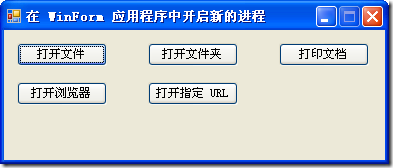WinForm 应用程序中开启新的进程及控制
来源:互联网 发布:网络信息安全主题班会 编辑:程序博客网 时间:2024/04/28 00:12
在 Winform 里有时会需要打开另一个应用程序或文件,比如打开浏览器、打开word文档、打开文件夹和打印文件等等。本文介绍用 C# 在 Winform 中打开一个新进程,完成上述功能。
using System.Diagnostics
该命名空间提供与系统进程、事件日志、性能计数器的交互。其中与进程相关的两个基本类是 System.Diagnostics.Process 和 System.Diagnostics.ProcessStartInfo
- System.Diagnostics.Procss:提供对本地和远程进程的访问,并使您能够启动和停止本地系统进程.
(1) Start ():启动进程,主要有如下参数设置
Start( ProcessStartInfo )
Start( string FileName )
Start( string FileName, string Arguments )
(2) 属性:
Id:唯一进程标识号
ProcessName:进程名称
MachineName:进程运行所在的计算机名
StartInfo:进程的 StartInfo
StartTime:启动进程的时间
ExitTime:退出进程的时间
HasExited:进程是否已经终止 - System.Diagnostics.ProcessStartInfo:与 Process 一起使用,为 Process 设置启动参数
(1) 构造方法:
ProcessStartInfo ()
ProcessStartInfo ( string FileName )
ProcessStartInfo ( string FileName, string Arguments)
(2) 一些属性:
FileName:应用程序或文件名
Arguments:参数
WorkingDirectory:启动进程的初始目录
CreateNoWindow:是否在新窗口启动进程
WindowStyle:指定打开窗口时的状态(枚举值)
Verb:打开进程时需要使用的谓词;每个文件扩展名都有它自己的一组谓词;可以使用 Verbs 属性获取这些谓词。例如,“print”谓词将打印使用 FileName 指定的文档。可使用空字符串 ("") 指定默认谓词。
下面用一个 WinForm 小程序来简单实现打开进程: 
首先,引入命名空间: using System.Diagnostics;
(1) 打开文件
private void btnOpenFile_Click(object sender, EventArgs e) { // 定义一个 ProcessStartInfo 实例 ProcessStartInfo psi = new ProcessStartInfo(); // 设置启动进程的初始目录 psi.WorkingDirectory = Application.StartupPath; // 设置启动进程的应用程序或文档名 psi.FileName = @"xwy20110619.txt"; // 设置启动进程的参数 psi.Arguments = ""; //启动由包含进程启动信息的进程资源 try { Process.Start(psi); } catch (System.ComponentModel.Win32Exception ex) { MessageBox.Show(ex.Message); return; } }
(2) 打开浏览器
private void btnOpenIE_Click(object sender, EventArgs e) { // 启动IE进程 Process.Start("IExplore.exe"); }
(2) 打开指定 URL
private void btnOpenUrl_Click(object sender, EventArgs e) { // 方法一 // 启动带参数的IE进程 Process.Start("IExplore.exe", "http://www.cnblogs.com/SkySoot/"); // 方法二 // 定义一个ProcessStartInfo实例 ProcessStartInfo startInfo = new ProcessStartInfo("IExplore.exe"); // 设置进程参数 startInfo.Arguments = "http://www.cnblogs.com/SkySoot/"; // 并且使进程界面最小化 startInfo.WindowStyle = ProcessWindowStyle.Minimized; // 启动进程 Process.Start(startInfo); }
(2) 打开文件夹
private void btnOpenFolder_Click(object sender, EventArgs e) { // 获取“收藏夹”文件路径 string myFavoritesPath = System.Environment.GetFolderPath(Environment.SpecialFolder.Favorites); // 启动进程 System.Diagnostics.Process.Start(myFavoritesPath); }
(2) 打印文档
private void btnPrintDoc_Click(object sender, EventArgs e) { // 定义一个进程实例 Process myProcess = new Process(); try { // 设置进程的参数 string myDocumentsPath = Environment.GetFolderPath(Environment.SpecialFolder.Personal); myProcess.StartInfo.FileName = myDocumentsPath + "\\TxtForTest.txt"; myProcess.StartInfo.Verb = "Print"; // 显示txt文件的所有谓词: Open,Print,PrintTo foreach (string v in myProcess.StartInfo.Verbs) { MessageBox.Show(v); } // 是否在新窗口中启动该进程的值 myProcess.StartInfo.CreateNoWindow = true; // 启动进程 myProcess.Start(); } catch (Win32Exception ex) { if (ex.NativeErrorCode == 1) { MessageBox.Show(ex.Message + " Check the path." + myProcess.StartInfo.FileName); } else if (ex.NativeErrorCode == 2) { MessageBox.Show(ex.Message + " You do not have permission to print this file."); } }
- WinForm 应用程序中开启新的进程及控制
- WinForm 应用程序中开启新的进程及控制
- WinForm 应用程序中开启新的进程及控制
- C#.NET WINFORM应用程序中控制应用程序只启动一次
- Android应用程序在新的进程中启动新的Activity的方法和过程分析
- Android应用程序在新的进程中启动新的Activity的方法和过程分析
- Android应用程序在新的进程中启动新的Activity的方法和过程分析
- Android应用程序在新的进程中启动新的Activity的方法和过程分析
- Android应用程序在新的进程中启动新的Activity的方法和过程分析
- Android应用程序在新进程启动Activity及结束进程
- C# Winform中打开一个新进程+实例
- 实现单进程(Single Instance)的.NET WinForm应用程序
- WinForm中登录窗体的新点子
- 多线程中控制winform的控件!
- winform中手机号的输入控制
- 转 Android应用程序在新的进程中启动新的Activity的方法和过程分析 .
- Android源码解析之应用程序在新的进程中启动新的Activity的方法和过程分析
- Winform程序中开启控制台
- 学习的第六天
- Android APK反编译详解(附图)
- Step-by-step learning C + +(chapter six summary____Statements)
- 在百度排名中稳坐第一
- AES加密算法
- WinForm 应用程序中开启新的进程及控制
- Android 的消息队列模型
- C#子线程中进行UDP报文的监听
- 固定浮动窗positioin:fixed浏览器(IE6 IE7 IE8 IE9 Chrome Firfox)兼容性解决方案
- adb 调试时经常出现device not found的解决方式
- android下libgdx 中文字符显示初探
- 学习的第七天
- 不在机房的这些日子
- 入侵php网站需注意哪些


